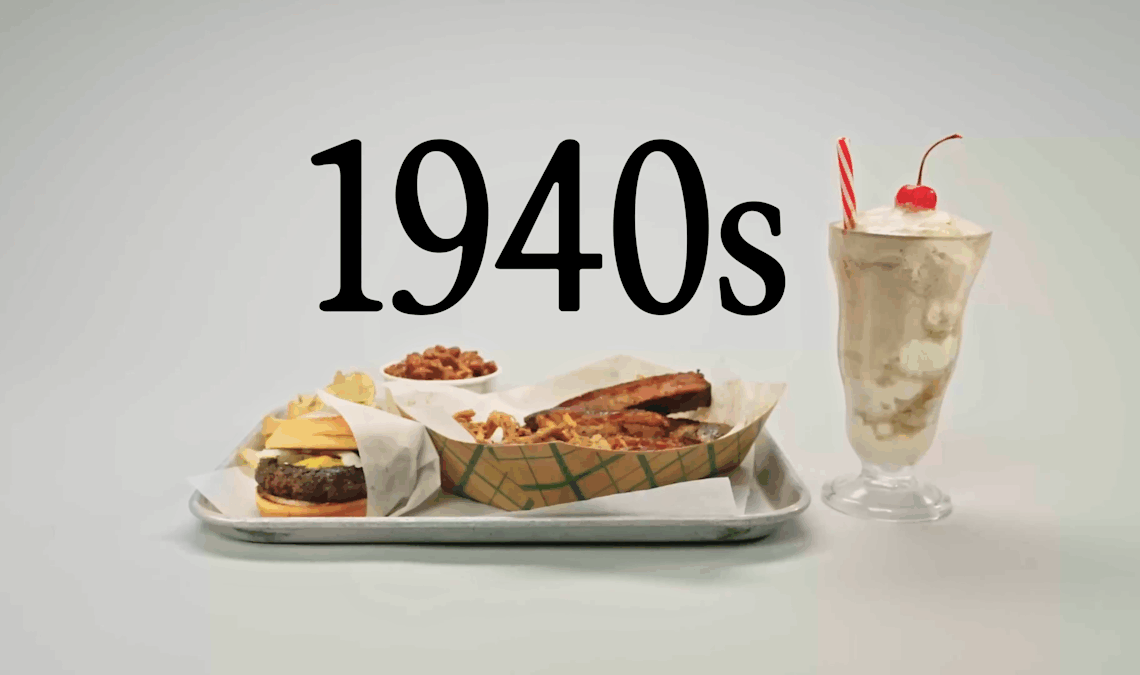I tasted nearly 100 years of McDonald’s using the actual recipes to recreate historic menu items and served them up in the real-deal, original packaging. Some of these recipes were nearly impossible to find, but fans of the Golden Arches around the world helped me out.
1940s: The inception of McDonald’s
McDonald’s first opened during World War II, a time when people needed cheap and filling meals. It was originally called McDonald’s Famous Barbecue, and they served classic barbecue instead of the beloved burgers and fries we have today. At this time, McDonald’s was serving potato chips, but made the switch to fries in 1949.
When McDonald’s started, customers drove up in their cars and sat in a parking lot, where they were served right in their vehicles by employees called “carhops.”
A nice pile of pulled pork, fries and a root beer float would run you 55 cents back in the day. The packaging for these foods was basic at the time of McDonald’s creation, but soon enough there would be a step up in the fast food’s presentation and marketing style.
1950s: Expansion era
Moving to the 1950s, a hamburger cost just 15 cents. If you ordered everything on the menu, it would cost just $1.16 at the time. McDonald’s was renamed to McDonald’s Famous Hamburgers in the late ’40s to early ’50s, and as a part of the rebrand, created an entirely new menu where they focused on just nine core items, all with descriptive names:
The meal I recreated from the 1950s menu included a hamburger, cheeseburger, milkshake and fries, which would have totaled to 64 cents.
The hamburgers during this decade were much thicker than what you see today — there was substantially more beef used per burger, and they were also cooked to a medium temperature, as opposed to the current practice of cooking them to be well done.
In this era, McDonald’s also created Speedee, a cartoon chef holding a sign that said, “I’m Speedee” to show how fast the service and cook time were.
In coordination with the Speedee logo and its marketing, the system McDonald’s used to achieve quick service was renamed to the “Speedee Service System.” Carhops were phased out, and the use of reusable dinnerware became a thing of the past when dishwashing began to slow down the service process.
1960s: Creativity and global growth
In the 1960s, McDonald’s started to get creative with some of its new menu items and even made the first-ever version of the iconic logo featuring the Golden Arches. During this decade, a hamburger cost 20 cents.
McDonald’s introduced a variety of menu items at this time and tested them against each other to see what was favored among customers. The Hula Burger, a meatless option with grilled pineapple, cheese and a toasted bun, went head-to-head with the now-legendary Filet-O-Fish.
The fish sandwich won in a landslide, and cost just about 29 cents at its introduction. Another invention in this decade that was here to stay is the Shamrock Shake, a mint-flavored vanilla shake with a green hue.
McDonald’s also started focusing more on convenience. It began to give customers trash bags with their meals so they could throw the food wrappers away after eating. Called the “Stickie Stasher,” you could stick the bag onto part of your car and seal it closed once you were finished.
1970s: Family focus
Entering into the 1970s, McDonald’s focused heavily on family values, which led to the creation of the Happy Meal that was (and still is) served with a toy. The McDonaldland characters that we still have today, like the Hamburgler, Grimace and of course, Ronald McDonald, were all introduced at this time. The Happy Meal totaled $1.10 and a hamburger cost 30 cents.
The first drive-thru also opened at this time, located at a McDonald’s near an Army base in Arizona. The franchise owner noticed a drop in sales because soldiers at Fort Huachuca couldn’t leave their cars while in uniform. To rectify the decline in sales, he added a drive-thru window. Franchises across the country quickly followed suit after seeing major success with the innovation.
The Big Mac, apple pie, cookies and popcorn were also introduced in the late 1960s to early 1970s. Although the popcorn was eventually phased out, the Big Mac, apple pie and cookies became a tried and true staple of the McDonald’s franchise.
1980s: Breakfast and beyond
Moving to the 1980s, McDonald’s focused on breakfast after the now-popularized drive-thru inspired many to pick up breakfast and coffee on their way into work. During this decade, a hamburger cost 50 cents.
Serving up hotcakes, sausage, hash browns and hot black tea, breakfast was a hit. By the late 80s, McDonald’s became responsible for serving one out of four breakfasts not cooked at home, making it a huge nationwide success.
Aside from breakfast food, the franchise also released a beloved menu item: Chicken McNuggets. Introduced in select markets in 1981 and released nationwide in 1983, the McNuggets had the four traditional shapes they still do today: the bell, ball, bow-tie and boot.
One menu item was tested and failed in the ’80s: the McDLT. A burger served in a two-sided polystyrene container, the packaging aimed to keep the burger patty hot and keep the lettuce, tomato and other potential toppings cold and uncooked from the heat of the patty.
The polystyrene container, necessary for keeping the product at its optimal temperature, was the downfall of the menu item. At the time, McDonald’s was receiving an increasing amount of criticism for its lack of sustainable measures, and the packaging used was not eco-friendly. Ultimately, the McDLT was pulled from the menu.
1990s: Premium push
In the 1990s, a hamburger cost 75 cents. McDonald’s wanted to get a little fancier in this era, and tried to go “premium” to compete with casual dining.
The 1990s saw McDonald’s try, and fail, to go upscale with higher-end items like the Arch Deluxe and McPizza. They faced challenges like long prep times and higher prices. The Arch Deluxe and McPizza were much pricier experiments than anything attempted in the past.
The McPizza was a personal-sized pie, made fresh to order. It started at $5.80 for a plain pizza, and went up to $9 if you wanted all of the toppings, which was much higher than anything else comparable on the menu. Not only did it fail because of the previously mentioned wait time, but the pizzas also did not fit through the drive-thru windows easily.
Eventually, McDonald’s reimagined the menu item and created a McPizza that had a similar shape to a Hot Pocket. It had a quicker cook time, but was still unable to become a major success. It phased out within a few years.
Also, in an effort to be more premium, the Arch Deluxe was a burger that catered more towards adults. With a more complex flavor profile, the Arch Deluxe had all of the traditional burger fixings with added peppered bacon and a mustard-mayonnaise sauce on a sesame bun.
The burger was taken off the menu by 2000, after it was decided that it did not fit the McDonald’s brand to serve premium food items with its traditional offerings.
2000s: Health and variety
In the 2000s, health and nutrition became a major focus in the United States, which led McDonald’s to introduce a variety of healthier options. At the same time, the company launched its iconic Dollar Menu, making fast food more affordable than ever. During this decade, a hamburger cost around 90 cents.
Salad Shakers were one ‘healthier’ item to enter the market at this time. The salads were served in clear plastic cups that customers would shake to mix, and could easily fit in the cup holder of a car.
Eventually, the packaging was replaced with standard bowls as the cups tended to leak dressing. The traditional McDonald’s salads ran on the national menu until 2020, removed as a method to streamline and simplify operations during the COVID-19 pandemic.
Another menu addition in the 2000s was the Snack Wrap. This item gained a diehard fan base nationwide, although not a massive one. Due to the low sales and time-consuming preparation, the beloved Snack Wrap was discontinued in 2016, but fans around the world are still calling for its return.
Another menu item introduced, not in line with the new health-conscious options, was the Angus Third Pounder. Heavier than the iconic Quarter Pounder, the Third Pounder had no other notable characteristics to make it stand out on the menu. The Quarter Pounder continued to come out on top, and the Third Pounder faded away in the distance.
Also, amidst the healthier options, a super size for sodas hit the menu, fitting about 3.5 regular-sized cups into one.
The Supersized menu phased out in the mid-2000s, in an attempt to streamline operations. It is also rumored that Morgan Spurlock’s incredibly popular documentary, “Super Size Me,” influenced McDonald’s to end its unhealthiest practices.
2010s: Global expansion
The 2010s were an era of global influence for the franchise. McDonald’s adapted to international markets and incorporated cultural flavors. A hamburger cost $1.15. Embracing globalization, the chain introduced unique menu items like the McLobster and region-specific McFlurry flavors. Collaborations with local markets helped continue to make McDonald’s a global phenomenon.
All-day breakfast was also introduced in this era, serving up morning favorites from dusk to dawn like the Egg McMuffin. The all-day breakfast was discontinued in 2020, similarly to the salads, due to the need to streamline services during the COVID-19 pandemic.
The McRib was also reintroduced nationally at this time, for a limited time only. Upon reintroduction, it saw major success. The McRib now comes back as a short-term menu item on occasion, around once per year.
2020s: Sustainability and collaborations
Finally: the 2020s. Currently, McDonald’s is focusing more on sustainability and pop culture collaborations. In this decade, a basic hamburger costs $2.19.
With the ever-growing popularity of social media, secret menu items have taken off in popularity, like the Land, Air and Sea Burger: combining a Big Mac, McChicken and Filet-O-Fish all in one. Customers must order each individual sandwich and assemble the Land, Air and Sea Burger on their own, but it is clear that social media has begun to influence the ordering pattern of customers in this decade.
Another recent menu item with social media-fueled growth was the Grimace Shake. Released in 2023 to celebrate Grimace’s 52nd birthday, the Grimace Shake ignited a wide array of social media trends, some a bit disturbing, while others stayed light-hearted.
Recent McDonald’s collaborations include working with talent like BTS, Travis Scott, Rick and Morty and Pokemon.
The future of McDonald’s
Who really knows what’ll happen in 2030 and beyond. We might see robot chefs, robot servers, lab-grown meat and maybe even 3D-printed food. As long as they stick to their iconic items along the way, I’m excited to see what’s next. What do you think McDonald’s will innovate in the future? Comment on my video below and tell me what you predict!
The post Recreating nearly 100 years of McDonald’s recipes appeared first on .




